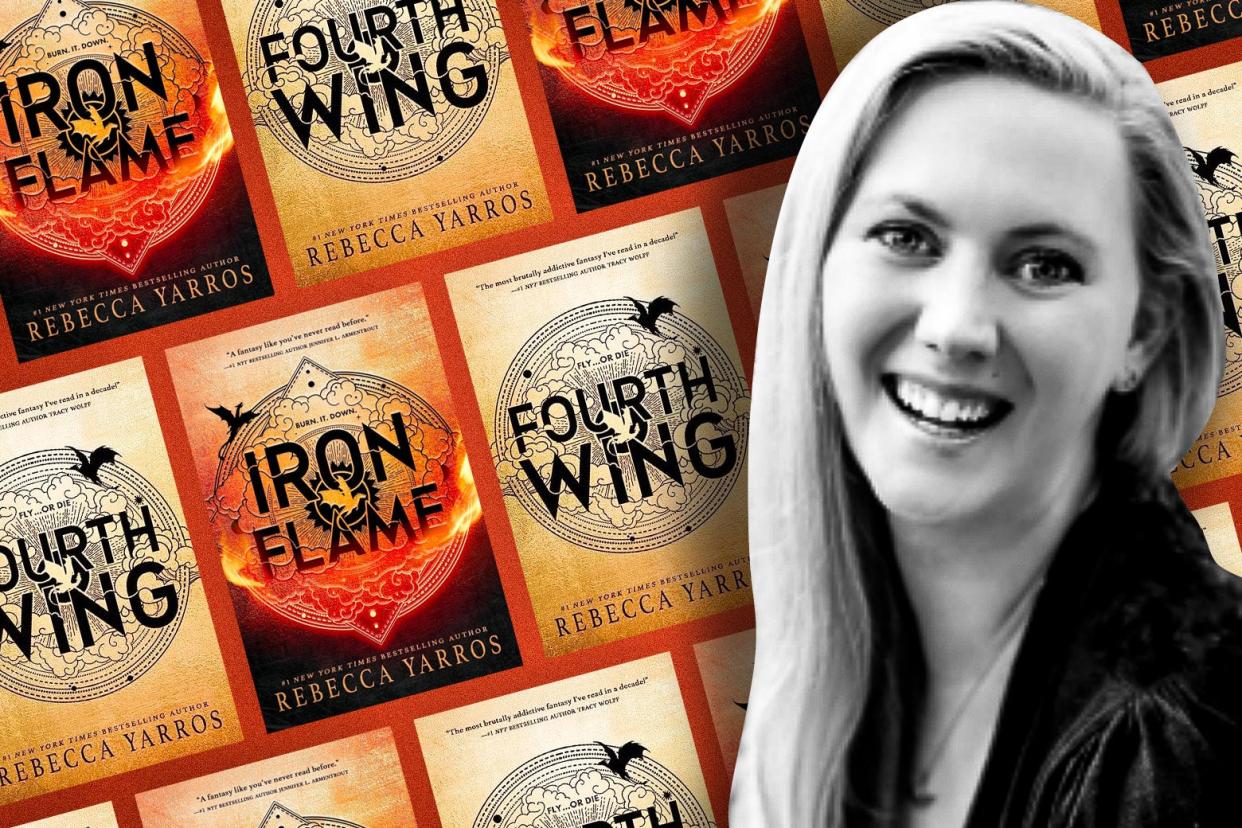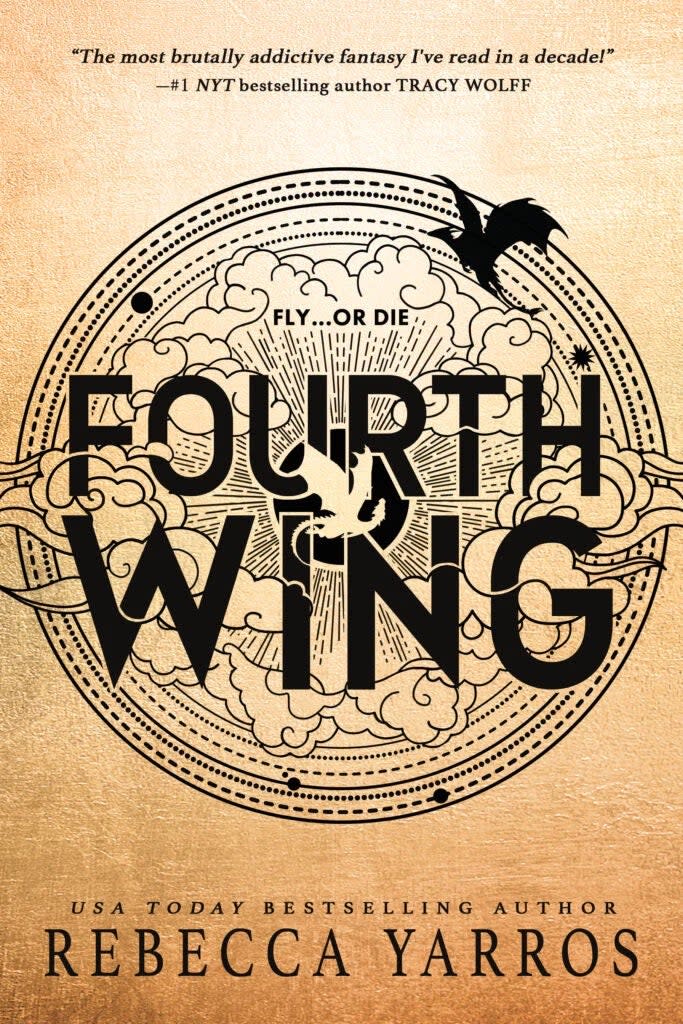I Read the Dragon-School Romances Dominating the Bestseller Lists. Yeesh.

For the past six months, it’s been difficult to budge Rebecca Yarros’ Fourth Wing off the top of the New York Times bestseller list. Well, this week, a new title finally will: Iron Flame, Yarros’ sequel to a novel that’s already sold 2 million copies. Amazon has just announced plans to adapt Fourth Wing as a streaming series, and Yarros was just profiled in the Times, embodying every fiction writer’s dream of skyrocketing to success after years of scribbling in obscurity—in Yarros’ case, writing more than 20 contemporary romance novels for her small publisher, Entangled.
As with Colleen Hoover’s ascension, BookTok can take much credit for Yarros’. A TikTok search on the #fourthwing tag returns countless videos of young women rapturously embracing their copies of Fourth Wing, the saga of Violet Sorrengail’s first year at the Basgiath War College, learning to become a dragon rider. The series belongs to a newish and flourishing hybrid genre called romantasy, which stages the romance genre’s familiar tropes against a fantasy backdrop. For a generation of readers raised on Harry Potter, Twilight, and The Hunger Games, this genre offers up the characters and conflicts of YA fantasy but with more profanity and explicit sex.
What’s Fourth Wing like? A more pertinent question would ask what it isn’t like. Seemingly every single sentence in its 528 pages includes at least one cliché, and you can spend hours on the internet discovering which other books readers believe that Yarros has plundered for themes and motifs. Violet is pale and weak like Twilight’s Bella Swan and smitten with a dark, brooding bad boy with the hilariously on-the-nose name of Xaden Riorson. Basgiath War College supplies warriors for the badly needed defense of the kingdom of Navarre, yet for some reason has no problem with a training program that kills off a hefty percentage of its students. The adult authorities, like the elites of The Hunger Games, are callous and fond of grandiose, barbaric rituals. And all this takes place at that most shopworn setting of all, a magical boarding school.
The dragon element of Fourth Wing might seem like a dollop of Game of Thrones, but Yarros’ system owes more to the long tradition of dragon-rider fantasy series by such authors as Cressida Cowell, Anne McCaffrey, and Naomi Novik. As is often the case with fictional dragons, the ones in Fourth Wing can communicate telepathically with humans, specifically their bonded riders, and because Violet’s and Xaden’s dragons are mated, the two human characters can speak in each other’s minds as well. This makes it easier for the couple to keep up the constant stream of sarcastic wisecracks that passes for sexy banter in Fourth Wing—and other romance novels deploying the hoary “enemies to lovers” trope. Xaden supposedly hates Violet because her mother, a general, put down a rebellion led by his father, and she hates him because her brother was killed in that war. But of course they also have the hots for each other and spend most of the novel fighting it before inevitably giving in to their love.
While bookish Violet, who expected to become a scribe until her ice-queen mom forced her into the rider academy, seems to her fellow students likely to be the first candidate to die, she naturally possesses secret untapped powers. Two hot guys—Xaden and a childhood friend she once fancied—alternate between protecting her and vying for her affections. Characters make a lot of overwrought proclamations about their feelings. And those feelings are signaled by a limited range of somatic eruptions. Violet’s stomach and heart are forever sinking and twisting and pitching and tightening in response to the vicissitudes of her status and the seemingly endless slow burn of her courtship with Xaden. For his part, the tattooed Xaden quirks smiles and rakes his fingers through his jet-black hair (quirking and raking, along with smirking, are consuming habits for romance heroes). Then he says things like “I’ve been yours for longer than you could ever imagine”—words that no man in real life has ever uttered without being up to no good.

In all, Fourth Wing is a Frankenstein’s monster of borrowed romance and fantasy devices, right down to Violet’s unusually colored hair, a trait that apparently no one informed Yarros is a classic sign of a Mary Sue. Yet the novel’s world building displays a real lack of commitment and creativity; the months have the same names as those of the Roman calendar (“December turns to January”), and Violet worries about being “attracted to toxic men.” You can see every plot development coming from a mile away: who will die, who will turn out to be lying, what the real dilemma of Navarre is behind a facade of propaganda.
Why is it so popular? It’s possible that many of the novel’s younger fans simply haven’t read enough to recognize how tired Yarros’ language and motifs are. Cliché makes reading a speedier process for people uninterested in anything but plot. But romance fans in particular have become fairly sophisticated consumers of their genre, speaking like connoisseurs of their favorite variations on such venerable tropes as “fake relationship,” “forced proximity,” and “friends to lovers.” What makes Fourth Wing risible to someone who wants something fresh or surprising from a novel makes it a familiar comfort to someone in search of an immersive escape. As violent and merciless as Violet and Xaden’s world is, it is governed by narrative laws that are reassuringly consistent and unbreakable. The more perilous and unpredictable the real world seems to be, the more appealing such scenarios become. Sure, you’ve read it all before, many, many times. That’s how you know that everything will turn out all right in the end.

